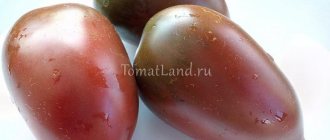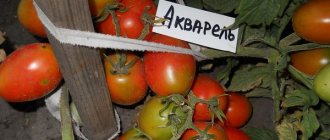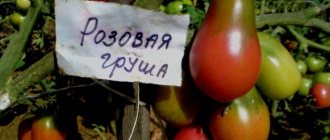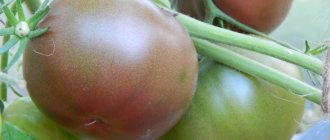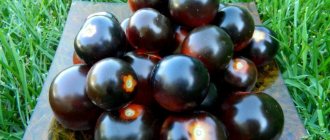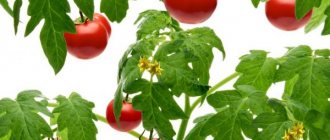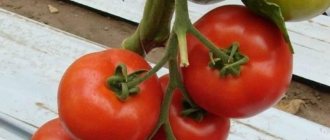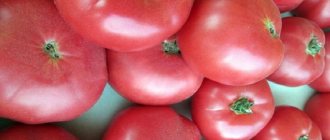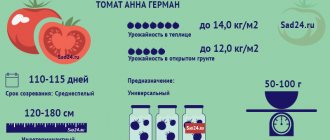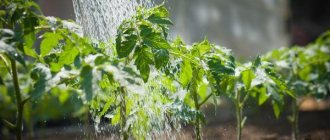An extravagant dark, almost black color and pear-shaped tomato looks amazing and exotic. But in addition to its unusual appearance, the Black Pear variety also has a pleasant taste, as well as excellent characteristics of yield, durability and content of nutrients.
| Height | Landing location | Ripening time | Fruit color | Fruit size | Origin | Fruit shape |
| Tall | Greenhouse, Open ground | Mid-season | Black | Average | Variety | Pear-shaped |
Description and characteristics of the variety
Origin of the variety
The Siberian Pear black tomato variety was bred about 20 years ago by Russian breeders. They achieved a high content of anthocyanins in the fruits - natural pigments that give eggplants and red cabbage their color. To get high-quality tomatoes with the characteristics declared by the manufacturer, you need to buy seeds from trusted sellers, for example, the Siberian black pear tomato Ural summer resident or the black pear tomato Aelita.
Landing region
The variety can be grown both in open ground and in a greenhouse; it will take root in different climatic zones. In central Russia and further north, in Siberia, it needs a greenhouse, and in the southern regions, open ground beds are suitable.
Ripening time and yield
Being an indeterminate, the bush grows 160-180 cm. This is a mid-season variety, the fruits reach maturity 110-115 days after the seeds hatch. Tomatoes are pear-shaped, weighing 55-80 g. The color of a fully ripe tomato is black-brown, while that of a not quite ripe one is burgundy. The pulp is dense, its shade matches the color of the peel.
Tomatoes contain a lot of carotene, antioxidants, anthocyanins, lycopene and vitamins A and C. They have a beneficial effect on vision, help maintain youth and prevent the development of tumors, and also strengthen the immune system.
Where to plant on the site?
The black pear tomato needs long daylight hours and direct sunlight. This feature indicates that plantings need open space with good lighting, but it is best to refuse a place in the shade. Low-lying beds are also bad for tomatoes. Large accumulations of water lead to the development of certain diseases.
If we talk about predecessors in one or another part of the garden where planting is planned, then beds with nightshade crops or corn are not suitable for planting tomatoes. But you can use the space after radishes, cabbage, and salads.
Diseases and pests
The black pear tomato is resistant to late blight, but can suffer from fusarium and blackleg. Both diseases are fungal and occur with excess moisture, insufficient ventilation and lighting. Sick plants must be removed immediately. To prevent fusarium, bushes are sprayed with a solution of Fitosporin, and Trichodermin is added to the soil against blackleg.
Whitefly
This parasite lives in greenhouses - small midges with white wings. Against them, nets are installed on the windows or tobacco is planted in the greenhouse, the leaves of which are treated with actellik.
Seedling
About two months (in the second half of March) before planting tomatoes, you should think about sowing seeds. To do this, you need to prepare the seeds as follows:
- 1) remove spoiled seeds;
- 2) soak in saline solution (a glass of water with 1 teaspoon of salt);
- 3) treat aloe for disinfection (mix juice with water in equal proportions), with a solution of soda or potassium permanganate.
- 4) to stimulate germination, treat with aloe or water with honey.
Black Baron
Indeterminate plants have a medium-early harvest period, no more than 110 days. The bushes are planted outside; if desired, they can be grown in a greenhouse. The stem is powerful, 1.8-2 m high, with little foliage. The fruits ripen in small clusters of 3-5 pieces each. The variety is resistant to major tomato diseases; there are no cases of late blight or blossom end rot. The variety is unpretentious in cultivation and does not require special attention from the gardener.
Burgundy-chocolate tomatoes are formed in the second half of summer. The taste is sweet and sour, the flesh is fleshy. The skin is thin but durable and reliably preserves the pulp from damage. The main purpose of the variety is fresh consumption and preparation. The fruits can be stored for a long time and have good keeping quality. The yield is average - up to 3 kg of tomatoes per bush. The Black Baron is famous for several advantages:
- beautiful coloring of fruits;
- meaty sugar taste;
- unpretentiousness in care;
- good keeping quality;
- universal application.
And the disadvantages gardeners note is the need for pinching: the plant is grown in 1-2 stems.
On a note!
Pruning of bushes is carried out in the morning. In the morning, the movement of juices inside the stem is moderate, so the stress for the plant will be minimal.
Features of outdoor care
Depending on the climate and the approximate date of transfer to a permanent place, the seeds are sown for seedlings in February, March or April - 50-70 days in advance. The soil should contain equal amounts of peat, turf soil and humus. For 10 liters of the mixture add 1 teaspoon each of superphosphate, urea and potassium sulfate.
In the first month, plants need a temperature of 23-24 degrees, then it is reduced slightly, and ventilation, on the contrary, is increased. 2 weeks before planting in the garden, the temperature is set at 19 (or the boxes with seedlings are taken out to the balcony). After the appearance of the second true leaf, the plants are planted, and a week later they are fed for the first time with an infusion of humus in water. After another week, feed again with urea, superphosphate and potassium sulfate or ready-made fertilizer.
It is better to plant bushes in the evening. The stem is buried halfway and watered well. Before planting, you can water the holes with a weak solution of potassium permanganate and do not fertilize for now.
After the first heavy watering, the procedure is stopped for 8-10 days. Afterwards, regular but not excessive watering is indicated.
The tomatoes are fertilized, the soil is loosened, and the weeds are weeded. Also, do not forget about bush formation and tying.
Mid-season / Tall
User rating: 4/5
Medium early/Tall
User rating: 5/5
Mid-season / Tall
In order for tomatoes to bring the long-awaited harvest, it is recommended to prepare the soil in the autumn months. In the place where black tomatoes will grow, humus is added to the soil, which will saturate it with useful elements. It is worth noting that an acidic environment is not suitable for vegetables. To reduce this indicator, chalk or charcoal is used. You can determine the pH of the soil by looking at some plants that do well in acidic soil. This applies to sorrel and horsetail.
Along with humus, you can add potassium and phosphorus fertilizers. Potassium nitrate containing nitrogen is the most beneficial. In order not to make a mistake with the choice of fertilizers, you should pay attention to those compounds whose components will remain in the soil layer for a long time.
The peculiarity of adding ammonium nitrate is that it is more advisable to use it in the spring. This product has the ability to dissolve quickly and will be washed out of the soil during precipitation.
To increase productivity, many gardeners form two trunks on one shrub. There is nothing complicated about it. For a black pear tomato, it is enough to cut off the shoots and leave only the one that grew under the very first bunch. The second stem will form from it. The fruiting period is extended by pinching the crown of the plant after several clusters have appeared. Do not forget about the tallness of the crop, as well as the timely tying of bushes.
As for care activities, they look like this:
- fertilization;
- after watering, be sure to loosen the soil;
- timely garter;
- removal of weeds.
Watering plays an important role in caring for tomatoes, and its frequency depends on climatic conditions and dryness of the soil. As soon as the soil begins to dry out, you can take up the watering can. Gardeners should not allow the garden bed to dry out completely.
If precipitation is not expected in the near future, then you need to water the vegetables once a week. In the presence of precipitation, the frequency of watering is reduced. The yield depends on the amount of water; a lack of moisture leads to the fact that the fruit ovaries may fall off or not reach the desired size, and the skin of the ripe fruits cracks.
Care in greenhouse conditions
Plants in greenhouses need fertilizing. Fertilizers are used for the first time after planting seedlings. The period of need for fertilizer can be determined by the active development of the bush. An excess amount of nutrients leads to rapid growth of the green part of the crop and to a reduction in ovaries.
The second feeding is carried out at the moment the first ovaries appear. The most suitable fertilizer at this time is ammonium nitrate, and it is best to use a 0.3% solution.
Benefits of Black Pear
Gardeners love the tall Pear for its productivity, excellent taste of fruits, and resistance to disease. The advantages also include:
- Possibility of growing in open ground and in greenhouses (it all depends on the region). With proper agricultural technology, yields will be high everywhere.
- Black pear fruits are high in vitamins and carotene.
- Resistance to diseases (especially late blight, cladosporiosis).
- Long fruiting periods.
- Universal use. In mid-summer, you can use Pear in salads; closer to autumn, the fruits are canned and salted.
- Keeping quality (fruits do not crack, suitable for transportation).
- You can collect seeds from the fruits and use your own seed material for the next season.
Experienced gardeners who have grown black pear note that the tomato is very picky about soil quality. It does not tolerate acidified soil, which affects the color of the fruit.
Therefore, when growing this variety, special attention should be paid to soil acidity indicators.
The requirement for regular feeding remains unchanged.
The plant is powerful, tall, produces a lot of fruit, so it is important to take care of 3-4 feedings during the growing season
And despite the fact that the variety is resistant to diseases, you should not forget about preventive measures.
We hope that our information about the Black Pear tomato variety will be useful to you.
Natalia Severova
Growing methods
The Red Pear tomato can be grown both according to the standard scheme - using seedlings, and without seedlings. Let's take a closer look at these two options.
Seedless method
Using this method, you can plant tomatoes both in a greenhouse and outdoors. Below are the most important points.
Soil preparation
The Red Pear variety places increased demands on the soil in which it grows.
It is very important that the soil is fertile, fertilized and loose
To ensure that the soil in the garden bed meets these requirements, dig it up before planting, loosen it and apply fertilizer:
It is better to fertilize at the same time as digging so that the minerals get into the lower layers of the soil.
Planting Tips
- Sow the seeds in such a way that there is a distance of 35-40 cm between them. Thickening is unacceptable, as it leads to loss of yield and crop diseases.
- Water the bed after sowing using warm water. If we are talking about open ground, cover the plantings with lutrasil or film on top: this measure will protect the seedlings from cold snaps.
Seedling method
A much more commonly used method. In our climate, it is the seedling option that leads to high and predictable yields.
Deadlines
To plant seedlings in the ground in May, the seeds should be planted a couple of months before this event. Optimal sowing dates: late winter - early spring.
Preparation
If you purchased the seeds in a store, there is no need for pre-sowing preparation. But if you harvested it yourself, we recommend treating the seeds in a solution of potassium permanganate. One and a half to two hours is enough to protect future tomatoes from fungus.
Priming
It is better to sow the seeds in a special seedling soil mixture sold in the store. The composition of such a mixture has already been thought out and balanced: no additional loosening or fertilizing is needed.
If you prepare the soil mixture yourself, be sure to disinfect the soil and apply the following fertilizers:
- potassium;
- phosphorus;
- growth stimulant;
- wood ash.
Conditions for seedlings
It is very important for the successful cultivation of tomato seedlings to ensure:
- competent and regular watering;
- long daylight hours;
- warm and mild microclimate.
Temperature
In order for the heat-loving crop to develop quickly and correctly, maintain the room temperature at +20-22 degrees. Remember that until the shoots appear, the temperature should be higher: +25-27 degrees.
Lighting
The place where the seedlings are located should be illuminated most of the day. As a rule, daylight hours are still short in March, so take care of additional lighting.
Picking
This procedure is performed when the seedlings form 2-3 leaves. Note that this tomato variety tolerates picking perfectly and without negative consequences.
Disembarkation
Tomato seedlings should be transplanted to an outdoor garden bed or greenhouse when the soil warms up to +15-18 degrees. It is clear that in greenhouse conditions, planting can be done much earlier. They are usually planted outside at the end of May, sometimes at the beginning of summer.
Let's get acquainted with the features of caring for red pear tomatoes.
Top dressing
Tomatoes need two minerals in particular: phosphorus and potassium. Apply these microelements throughout the growing season, keeping a break of 4 weeks between feedings. Before fruit ovaries begin to form, nitrogen fertilizing is also recommended.
In addition to mineral supplements, you can also use folk remedies:
Loosening
The soil in the tomato bed should always remain permeable. To achieve this, be sure to loosen the soil after watering and rain (if we are talking about open ground).
Pruning, pinching
Since the variety is indeterminate, the above procedures cannot be avoided. Usually the bush forms one or two stems - this is quite enough to achieve the optimal ratio of the size of the fruits and their quantity.
Exotic miracle vegetable
True, today gardeners are hardly surprised by black tomatoes, since many try them, grow them and, as a rule, are satisfied. Here the question and the problem are more likely in different ways: how from a huge variety of varieties and hybrids of these “blacks” do they choose the most suitable for specific growing conditions?
Feedback from those who planted, information from experts and, of course, your own growing experience will help.
Black pear is an indeterminate type of tomato, and the plant has a very powerful, strong stem. The height reaches about 1.8 meters, or even all two.
The variety is intended for planting in greenhouses; it can be grown in open ground only in the southern regions.
The harvest can be harvested after about 113-115 days, that is, a mid-ripening tomato. Typically, Pear fruits begin to ripen in mid-July and the bushes bear fruit until the fall.
Feature of the variety: The leaves of the Black Pear are one-to-one similar to potato leaves. That is why many gardeners who grow the variety call it potato tomato.
A tall plant requires a mandatory garter and pinching. The first cluster is usually tied above the 9th leaf. It is recommended to grow a tomato with two stems; in order for all the fruits to set normally and fill, you will need to pinch the stem (after 7-8 bunches).
Indeterminate black pear is planted according to the scheme of 3-4 plants per square meter. It does not tolerate thickening, so it is worth taking this feature into account.
